|
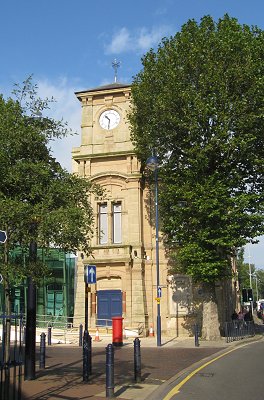
Listing: 1872-3. Library addition 1880. By Bidlake and Lovatt. Free
Classical style.
Pevsner: 1872-3 by Bidlake and Lovatt. With a tower. What can one call
this style? Segmented-headed windows and Early Gothic capitals?
Comment: Recent (2005) research by the city council indicates that
this building originated when a move was afoot to build a public library in
Bilston and the town hall use got added to it almost as an afterthought.
An enabling Act was passed and work on the combined building was started in
1871. The first, front, part was officially opened on 14th June 1873.
Land acquisition costs of £1100 and building costs of £5170 are recorded.
These original buildings had class rooms on the second floor which were
associated with the Library, as well as the usual council chamber and
committee rooms.
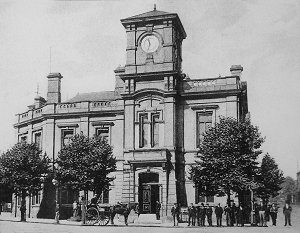 |
An early photo of the Town Hall,
possibly 1890s. Note the window to the right of the
entrance.
This was blocked up, at some unknown date,
with stone panelling which looks as it it was meant
for some sort of commemorative plaque. |
The addition in 1880 (which is an architectural
exact match) was presumably also by Bidlake and Lovatt; and, according to
its foundation stone, was built as a library extension. It appears
that the town hall use had expanded sufficiently to push out the library.
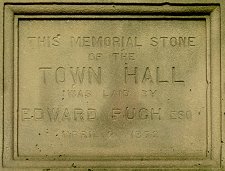 |
"Memorial" stones
for the Town Hall and the Library, both dated 1872. |
 |
 |
"Commemorating"
stones for the extension, both dated 1880. |
 |
The local authority in the building became the Bilston Urban District
Council in 1894 and the Bilston Borough Council in 1933. But the
building saw many other uses, especially the ball room on the first floor
which was, at one time, leased to Mr. Woods as a cinema. When he built
Wood's Palace, on the other side of the road, the ballroom reverted to its
original use and is well remembered for regular dances as well as special
functions.
| The billboard above the main door
to the Town Hall advertises Woods Palace, which, at the
time, occupied the ballroom. The notice reads:
"Professor Wood's Picture Palace Open Nightly".
|
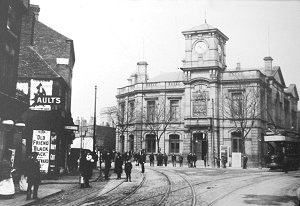 |
Under local government re-organisation Bilston took over Wolverhampton
(or, perhaps, the other way round) and the seat of local government moved to
Wolverhampton. The Bilston Town Hall was used as a local
administrative centre, chiefly occupied by the Housing Department. It
was last used in 1996.
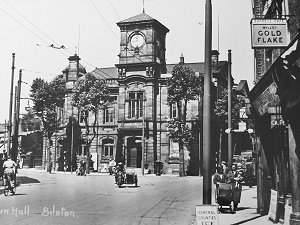 |
The Town Hall, sometime in the
1930s. |
The building has been, for more than a century, the building which
defines and stands for Bilston, a reminder that Bilston was a town of its
own and remains so, even if local government services are provided by a
council with another name. When it fell into disuse and decay a local
movement started to preserve it, lead by the Priest of Holy Trinity. The
city council got a report from one of its senior officers that the building
was in a dangerous condition. This proved to be untrue and the locals
renewed the pressure. By 2000 the
Wolverhampton City Council was desperately trying to sell it off in the hope
that a purchaser would bring it back to life. But they had no success,
at least in part because prospective purchasers could not be convinced that
the building was not falling down. The local pressure for preservation
continued, now lead by the Vicar of St. Leonard's. In 2001 the council set up a Building Preservation Trust with this building as its
prime target.
|
Part of the tiled entrance floor -
in best Victorian style - by Minton or someone like that. |
 |
The council then decided that in order to find any sort of use for the
building it would have to be restored. But they were confronted by the
alleged structural problems. These problems were said to have been caused by
people digging for coal in the street outside, in 1906. In fact the
digging in question was for laying new sewers - the coal turned up in the
trenches, as it is likely to turn up anywhere in Bilston, and was removed.
Coal exists at a lower level as well and this was mined at the end of the
19th century. When restoration work eventually started it was known
that some mines lay underneath the Town Hall but others were then found.
It is thought that some of the workings went back to at least 1700.
The geotechnical engineer, Rob Freewood, was later (21st March 2009,
Express and Star) as saying; "Partially open and former collapsed
workings were encountered at shallow depth beneath the Town Hall.
These included shallow workings within tghe Staffordshire thick coal.
A 15 metre deep mine shaft down to the lower thick coal was also located".
 |
An old postcard which claims to
show colliery workings under the Bilston Town Hall. |
|
The Town Hall shored up, prior to
underpinning. |
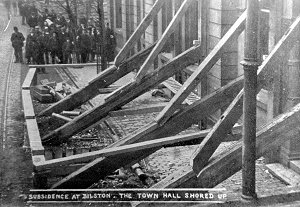 |
In 2006 a small, purple painted box was handed over to the vicar of
St. Leonard's, the Rev. Chris Thorpe. The box contained a lump of
coal with a label attached saying "Candle used by G. H. Hallet for
underneath Bilston Town Hall. 21.5.1906." to which has been added
in pencil (and maybe in another hand) "This coal was on the roof of a
12ft seam of coal". This curious item is now in the possession of
the Black Country Memories Club.
The subsidence in the Town Hall was repaired at the time in 1906.
The new and through survey work which the council carried out showed that the work done at the time was good and
remains so. There was no need for underpinning - and it might not even be
desirable, as underpinning can cause its own problems. But an
extensive stabilisation project was needed during the recent restoration
to deal with the workings beneath the Town Hall.
 |
The extensive cellars appear to be
in remarkably good order for a building that was supposed to
have been collapsing into a coal mine. |
By 2005 the council got a new found enthusiasm for regenerating
Bilston and has obtained funding which included money for the Town Centre
Heritage Initiative which has had marked success in several of the town centre
streets. Funding also came from the city council itself, the European
Regional Development Fund and Heritage Lottery. Work started by repairing and restoring the shell and the roof and
exterior generally, and the cellars and the clock tower. As that was being
done the search for new uses and tenant continued. Eventually
Wolverhampton Homes (the council's housing department in another guise) took
much of the building and the Gazebo Theatre Company took most of the rest.
They use the ballroom for productions, but the ballroom is also used for other functions, such as
dances.
|
The ballroom in its last state
before the restoration started. Note the proscenium
arch. |
 |
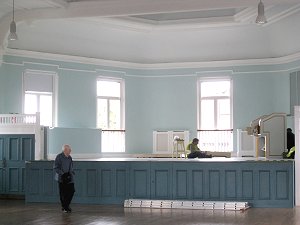 |
The ballroom in its restored date.
During restoration at list six layers of redecoration were
found, none of which, especially the earliest, looked very
attractive. The decision was taken to go for something
new. At the re-opening everyone loved it. |
The ballroom has been greatly improved by a group of volunteers who
paid for the acquisition of a pipe organ and then restored it, added to
it and installed it - a remarkable effort and highly laudable gift to
Bilston.
|
The organ console. The pipes
and other parts occupy the original room behind the lattice
screen to the right of the stage.
The console is on a
wheeled base, so that it cam be moved to one side when not
in use. |
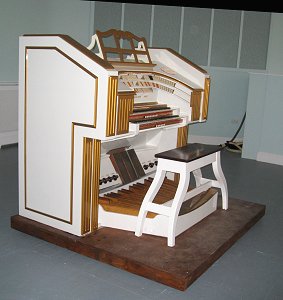 |
The new uses required improved access to the upper floor and, in
particular, a lift. The only place that could be found for this
was the old entrance lobby and the tower above it. That meant
providing a new entrance. The decision was taken to make this a
contrasting and obviously new addition, rather than to produce something
retro or fake. So the new entrance is a green glass box with ramps
leading to it. Nobody likes it - though it will probably be
conceded that, given the situation, it is as good as you were likely to
get.
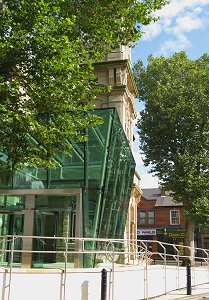 |
The new glassed entrance lobby. |
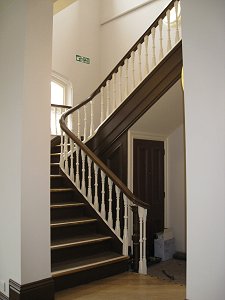 |
The main staircase
to the ballroom now looks coolly elegant. |
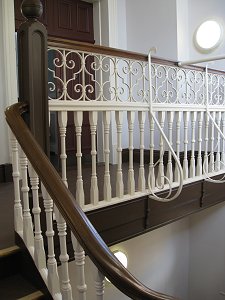 |
After much delay while plans were drawn up to make the building fit
for its new uses, and the new tenants started to move in, the restored
Town Hall was re-opened with due ceremony on the 19th September 2008,
with a traditional dance the following day - which sold out almost as
soon as the tickets went on sale. Bilston had got its Town Hall
back.


|